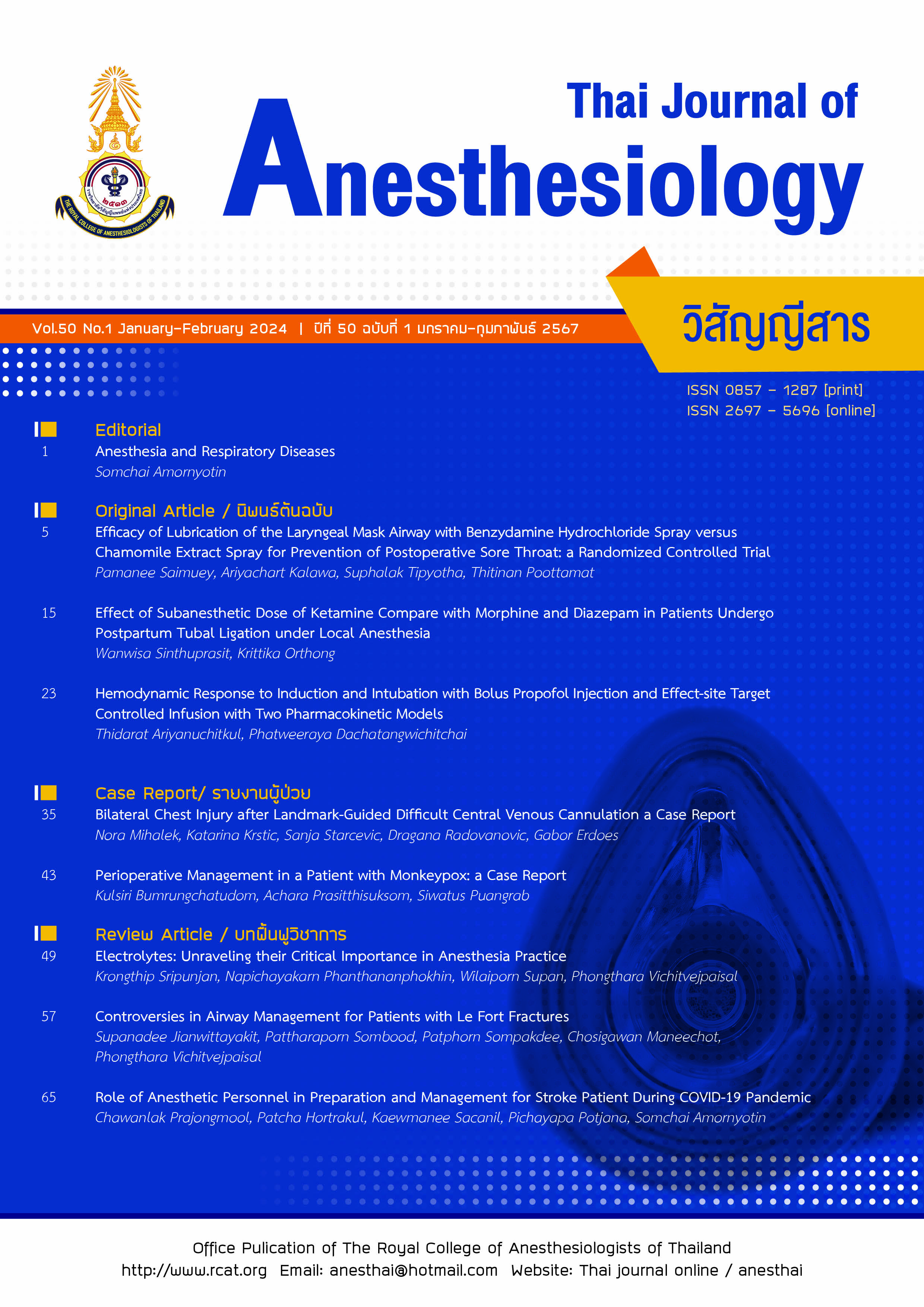Controversies in Airway Management for Patients with Le Fort Fractures
Main Article Content
บทคัดย่อ
The clinical management of patients with Le Fort fractures requires close collaboration between surgical and anesthesia teams to provide individualized care. Careful consideration and decision-making are necessary for selecting the timing and technique for airway intervention, as well as for managing complications and contingency planning. Critical factors include preoperative assessment, airway access and securing techniques, intraoperative ventilation, and postoperative care. However, there is ongoing debate regarding the timing of tracheostomy in patients with Le Fort fractures: whether it should be performed pre-operatively or post-intubation. While some anesthesiologists suggest early tracheostomy before surgery as a potential option, its use remains controversial due to the surgeon’s preference for post-intubation intervention, as it may increase the risk of complications in this patient population. Future research is needed to advance the field of airway management in this patient population, including advanced medical imaging and predictive models, novel airway management techniques, and patient-reported outcomes. By implementing these clinical considerations and advancing research, we can improve patient care and outcomes in this complex and challenging patient population.
Article Details

อนุญาตภายใต้เงื่อนไข Creative Commons Attribution-NonCommercial-NoDerivatives 4.0 International License.
เอกสารอ้างอิง
Mohan R, Iyer R, Thaller S. Airway management in patients with facial trauma. J Craniofac Surg. 2009;20:21-3.
Lee SS, Huang SH, Wu SH, et al. A review of intraoperative airway management for midface facial bone fracture patients. Ann Plast Surg. 2009;63:162-6.
Barak M, Bahouth H, Leiser Y, El-Naaj IA. Airway management of the patient with maxillofacial trauma: Review of the literature and suggested clinical approach. Biomed Res Int. 2015;2015:724032.
Jacomet A, Tasman AJ. Airway management in facial trauma patients. Facial Plast Surg. 2015;31:319-24.
Saini S, Singhal S, Prakash S. Airway management in maxillofacial trauma. J Anaesthesiol Clin Pharmacol. 2021;37:319-27.
Ray BR, Kumar BD, Devalina G, Anjan T, Ajoy R, Ongkila B. Anaesthetic management of maxillofacial trauma. Trends Anaesth Crit Care. 2013;3:231-7.
Ghabach MB, Abou Rouphael MA, Roumoulian CE, Helou MR. Airway management in a patient with Le Fort III Fracture. Saudi J Anaesth. 2014;8:128-30.
Jain U, McCunn M, Smith CE, Pittet JF. Management of the traumatized airway. Anesthesiology. 2016;124:199-206.
Ghysen D, Ozsarlak O, van den Hauwe L, van Goethem J, De Schepper AM, Parizel PM. Maxillo-facial trauma. JBR-BTR. 2000;83:181-92.
Chukwulebe S, Hogrefe C. The diagnosis and management of facial bone fractures. Emerg Med Clin North Am. 2019;37:137-51.
Sobiesk JL, Munakomi S. Anatomy head and neck nasal cavity. [cited 2023 may 17]. Available from: https://www.ncbi.nlm.nih.gov/books/NBK544232/.
Kamrani P, Sadiq NM. Anatomy head and neck oral cavity (mouth). [cited 2023 may 17]. Available from: https://www.ncbi.nlm.nih.gov/books/NBK545271/.
Furlow PW, Mathisen DJ. Surgical anatomy of the trachea. Ann Cardiothorac Surg. 2018;7:255-60.
Bagheri SC, Holmgren E, Kademani D, et al. Comparison of the severity of bilateral Le Fort injuries in isolated midface trauma. J Oral Maxillofac Surg. 2005;63:1123-9.
Hwang K, Lee DK, Chung IH, Lee SI. Le Fort I osteotomy with sparing fracture of lateral pterygoid plate. J Craniofac Surg. 2001;12:48-52.
Yang J, Trivedi A, Alvarez Z, et al. Predicting difficult airway Intubation based on maxillofacial trauma: a retrospective study. Cureus. 2022;14:e24844.
Glasheen J, Hennelly D, Cusack S. Maxillofacial Injury-not always a difficult airway. Prehosp Disaster Med. 2015;30:421-4.
Kolte VS, Shenoi RS, Ingole PD, Karmarkar JS, Rajguru JG, Deole SS. Finding a way for airway: a retrospective study. Minerva Surg. 2021;76:173-8.
Krohner RG. Anesthetic considerations and techniques for oral and maxillofacial surgery. Int Anesthesiol Clin. 2003;41:67-89.
Raval CB, Rashiduddin M. Airway management in patients with maxillofacial trauma-a retrospective study of 177 cases. Saudi J Anaesth. 2011;5:9-14.
Mittal G, Mittal RK, Katyal S, Uppal S, Mittal V. Airway management in maxillofacial trauma: do we really need tracheostomy/submental intubation. J Clin Diagn Res. 2014;8:77-9.


